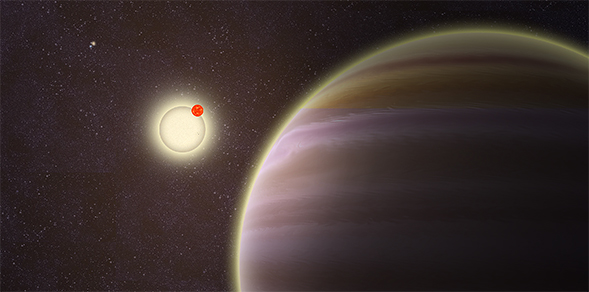Armchair Astronomers Find 4-Sun Planet
Two SDSU professors confirmed the amateur discovery of a planet orbiting twin suns that is orbited by a second distant pair of stars.

A joint effort of citizen scientists and professional astronomers led to the discovery of a planet orbiting twin suns that is orbited by a second distant pair of stars.
Aided by volunteers using the Planethunters.org website, a Yale-led international team of astronomers, including two from San Diego State University, confirmed the discovery, called a circumbinary planet in a four-star system.
Only six planets are known to orbit two stars, according to researchers, and none of these are orbited by distant stellar companions.
San Diego State contribution
“Despite the chaotic forces that were present two billion years ago when these stars were born, this planet managed to form out of the maelstrom,” said SDSU astronomer William Welsh. “It is telling us once again that nature likes to make planets.”
Welsh and SDSU colleague Jerome Orosz were previously part of NASA’s Kepler space telescope team that discovered the first known multi-planet circumbinary system.
“Circumbinary planets are the extremes of planet formation,” said Meg Schwamb of Yale, lead author of the paper presented Oct. 15 at the annual meeting of the Division for Planetary Sciences of the American Astronomical Society.
“The discovery of these systems is forcing us to go back to the drawing board to understand how such planets can assemble and evolve in these dynamically challenging environments.”
“The hard work of the Planet Hunters helps ensure that important discoveries are not falling through the cracks.”
Citizen scientists
Dubbed “PH1”, the planet was first identified by citizen scientists participating in Planet Hunters. It is the project’s first confirmed planet.
Volunteers Kian Jek of San Francisco and Robert Gagliano of Cottonwood, Arizona, spotted the faint dips in light caused by the planet as it passed in front of its parent stars.
Schwamb led the team of professional astronomers that confirmed and characterized the planet, using observations from the Keck telescopes on Mauna Kea, Hawaii.
PH1 is a gas giant with a radius about 6.2 times that of Earth, making it a bit bigger than Neptune.
“The thousands of people who are involved with Planet Hunters are performing a valuable service,” said coauthor Orosz. “Many of the automated techniques used to find interesting features in the Kepler data don’t always work as efficiently as we would like. The hard work of the Planet Hunters helps ensure that important discoveries are not falling through the cracks.”
About PH1
PH1 orbits outside the 20-day orbit of a pair of eclipsing stars that are 1.5 and 0.41 times the mass of the Sun. It revolves around its host stars roughly every 138 days. Beyond the planet’s orbit at about 1000 atronomical units (roughly 1000 times the distance between Earth and the Sun) is a second pair of stars orbiting the planetary system.
Gagliano, one of the two citizen scientists involved in the discovery, said he was “absolutely ecstatic to spot a small dip in the eclipsing binary star’s light curve from the Kepler telescope, the signature of a potential new circumbinary planet.” He continued, “It's a great honor to be a Planet Hunter, citizen scientist, and work hand in hand with professional astronomers, making a real contribution to science.”
Jek expressed wonder at the discovery: “It still continues to astonish me how we can detect, let alone glean so much information, about another planet thousands of light years away just by studying the light from its parent star.”
The paper has been submitted to the Astrophysical Journal. A team from Johns Hopkins University has been working on a separate paper on aspects of the planetary system.
The research was supported by NASA and the National Science Foundation.
For information about SDSU's role in the Kepler mission, visit sdsu.edu/kepler.



